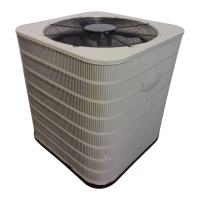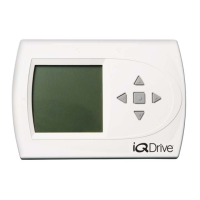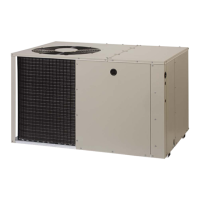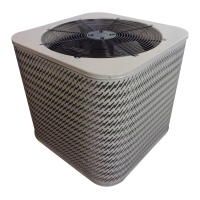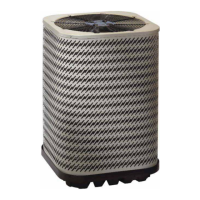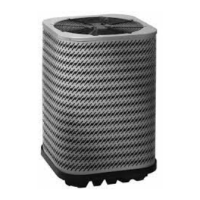7
Application Notes & Charging Info
(Cooling Mode Only)
• This equipment’s cooling system contains
refrigerant under high pressure. Always use safe
and environmentally sound methods when handling
refrigerant handling or servicing the unit. Review the
factory literature and safety warnings prior to servicing.
• Whenrepairingsystemleaks,alwaysuseanitrogen(inert)
gas to protect the refrigerant system and pressure check the
repair before re-charging. Always replace the filter-dryers
when performing any repair to the refrigeration system with
one capable of acid removal. After completing the repairs,
evacuate the system to 350 - 500 microns and weigh in
the refrigerant to the amount specified on the unit rating
label.
• The refrigerant charging chart is valid for a variety of
indoor, return air conditions and are most influenced by
the outdoor ambient temperature, outdoor fan operation
and the unit operating voltage.
S4BE-018KA SERIES
SUCT.
PRESS.
OUTDOOR TEMPERATURE (°F)
70 75 80 85 90 95 100 105
LIQ.
PRESS.
DIS.
TEMP.
LIQ.
PRESS.
DIS.
TEMP.
LIQ.
PRESS.
DIS.
TEMP.
LIQ.
PRESS.
DIS.
TEMP.
LIQ.
PRESS.
DIS.
TEMP.
LIQ.
PRESS.
DIS.
TEMP.
LIQ.
PRESS.
DIS.
TEMP.
LIQ.
PRESS.
DIS.
TEMP.
135 239 119
137
240 122
262 122
139 241 126
263 125
285 125
141
243 129
264 129
286 128
308 129
143 244 133
266 132
287 132
309 132
330 132
145 267 135
288 135
310 135
331 135
353 135
147 289 138
311 138
332 138
354 138
376 138
149 312 140
333 140
355 141
377 141
399 142
151 313 143 334 143
356 143
378 144
400 144
153 335 146 357 146
379 146
401 147
155 358 149 380 149
401 149
157 381 152 402 152
159 403 155
161
Table 3. Charging Table for 1.5 Ton Models
Shaded boxes indicate flooded conditions.
Rated design values. The suction pressure will vary from design value if indoor air flow, entering dry
bulb, or entering wet bulb temperatures are lower than design.
1. All pressures are listed in psig and all temperatures in ° F
2. Discharge temperatures greater than charted values indicate an undercharged system.
3. In Cooling Mode, suction pressure will be lower than design value if indoor air flow, entering dry bulb, or entering
wet bulb temperatures are lower than design.
4. In Heating Mode, charge should be weighed in. It is strongly recommended to verify charge in cooling mode at
ambient above 70°F.
NOTE: Before using Figure 3, (page 11), make sure
the unit is in a stable operating mode. As shown in the
chart, the ideal system sub-cooling can vary over the range
of operation. Reference the chart to determine the ideal
amount of sub-cooling for a given liquid pressure. Units
charged to other values will not perform at the rated unit
efficiency (EER) or rated Coefficient of Performance (COP)
in heating mode.
• Toinspectasystemsoperationusingqualityinstruments,
match the measured liquid temperature to the units table.
The measured liquid pressure reading should be within
3% of the table value for most installations.
• For systems that are operating with more than a 5%
deviation, inspect the unit for the proper voltage and phase
balance and the refrigeration system for leaks.
• Unitsthatareoperatingatlessthen95%ofthenominal
voltage or with a 2% phase imbalance may see a more
significant deviation than the amount stated above.
• DO NOT use the charts in systems that have a fan cycling
under low-ambient control. Refer to the low-ambient kit
instructions for more information (If applicable).

